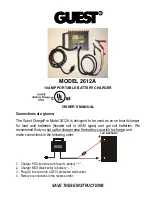
MAN-000020-00 REV A
3
Chemical Hazard.
Working with lead-acid batteries may result in exposure to
highly corrosive acid. To protect eyes and skin, use the required
P
ersonal
P
rotective
E
quipment (
PPE
)
as mandated by your employer and local
regulations. At a minimum, wear safety goggles and skin protection while
connecting the battery charger or working in the vicinity of lead-acid batteries.
Follow the battery manufacturer's published instructions when installing,
charging, and servicing batteries.
Use only with rechargeable batteries
. Do not attempt to charge other battery
types; doing so may cause equipment damage and result in serious personal
injury.
Do not expose the charger to rain or snow
. The charger is
NOT
designed for
outdoor use.
Adequate Cooling Required
. To prevent damage from overheating, proper
airflow must be ensured. Do not restrict fan inlets or exhaust outlets. Do not
mount the charger in a confined space or where the exhaust air will recirculate.
No User Serviceable Parts
.
If service is required, contact Power Designers USA
LLC or its service representative.
These instructions assume a certain level of competence by the installer
and/or user
. The following practices and codes contain relevant information, and
should be consulted for safe installation, testing, handling, and maintenance of
rechargeable lead-acid batteries. All applicable state and local codes must be
followed.
N
ational
E
lectrical
S
afety
C
ode
(
NESC
), ANSI/IEEE C2-2007 (or latest
revision). Copies may be obtained by contacting: The
I
nstitute of
E
lectrical
and
E
lectronics
E
ngineers, Inc. (
IEEE
), Publications Office, 10662 Los
Vaqueros Circle, P.O. Box 3014, Los Alamitos, CA 90720
www.ieee.org
N
ational
E
lectrical
C
ode (
NEC
) NFPA-70 (or latest version) available from:
National Fire Protection Association, 1 Batterymarch Park, Quincy, MA 02269
www.nfpa.org
CAUTION
WARNING






































